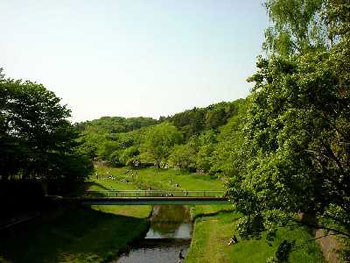Smack in the middle of the suburban sprawl that stretches from Tokyo all the way to the mountains west of the Kanto Plain, there is a fortuitous donut-hole of greenery formed by the confluence of several metropolitan parks, the vast Tama Cemetery, and a university campus so broad and verdant it looks like it belongs in Iowa, not Tokyo. International Christian University acquired this attractive chunk of real estate after World War II, when it had served as the headquarters of Nakajima Aircraft, developer of the Zero fighter. But long before this spot was used to turn out machines of war or idealistic scholars, it was home to the first pottery makers in the world.
ICU campus sits atop the Kokubunji Escarpment, a geologic formation created by the ancient course of the Tama River, which now flows several miles to the south. The top of the bluff affords spectacular views of Mt. Fuji, seventy miles away. The Jomon people who populated the Kanto Plain between 14,000 and 400 BCE must have liked the view, too, because they built a string of villages along the blufftop, several within the ICU precincts. They also produced a lot of pottery, much of it very large and quite ornate (Jomon means "cord-patterned"; ropelike patterns are a hallmark of their work). It was not until the 1950s that carbon dating confirmed that some Jomon ware dates back to 10,000 BCE -- 2,000 years before pottery was produced anywhere else.
To its credit, ICU has a small but highly edifying museum on its campus that does justice to the institution's Mesolithic predecessors -- and to the archeologists and students who unearthed their handiwork. Named after the university's first president, the Hachiro Yuasa Memorial Museum is a treasure trove of things Jomon. Besides Jomon tools, accessories, and a stunning collection of huge clay urns (the Jomon thought big -- these were used for food storage, as well as for burial), the museum boasts the reconstructed stone floor of a Jomon dwelling and an actual cross-section of the Kanto Loam (much of it volcanic ash from Mt. Fuji) that preserved these objects for so many millennia. You can also examine a detailed map of the area, pinpointing all of the diggings on the campus since the mid-fifties that have yielded these artifacts.
I must confess here that I have a particularly sentimental attachment to this exhibit because I grew up on the ICU campus. Our neighbor was archaeology professor J. Edward Kidder, one of the world's foremost experts on the Jomon. Every time excavations began for a new dormitory or faculty residence on campus, Dr. Kidder would be there with his students, poring over the site to ensure that no Jomon relics were inadvertently bulldozed.
Visitors to the Kidder house usually had to run a gauntlet of pottery shards laid out on the floor or the dining room table like so many jigsaw puzzle pieces. The Kidder kids were the envy of us all because they got to help their father put these urns together, and if you were lucky they might let you help out. Some of the urns I saw in the Kidder dining room now stand in the Yuasa Museum.
Let me hasten to add, however, that you do not have to be a childhood Jomon enthusiast to enjoy the Yuasa Museum; its original raison-d'etre was to hold Yuasa's impressive collection of mingei folk art, some 1,000 pieces of which are always on display. It also holds special exhibitions of Asian arts and crafts; "Ikats from Indonesia" are on display until November 22, 2007.
 |
The Kokubunji Escarpment:
ICU's Jomon sites are atop this bluff above the Nogawa River
©Mano Juhske |